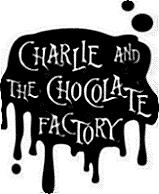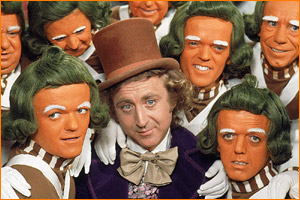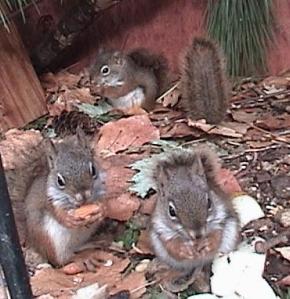Willy Wonka: One of Us
January 19, 2009
 |
The famed hero of a beloved children’s book a member of our elite group? It can’t be! And yet it is. Willy Wonka is an oppressor, a whimsical tyrant, a totalitarian overlord; whatever name you want to slap on him, the fact is the man is a dictator. The question is not why I believe this, but rather why you do not. Everyone who has read the children’s novel Charlie and the Chocolate Factory by Roald Dahl seems to be under the impression that Willy Wonka is the good guy. After all, he’s the man with the chocolate factory, every kid’s wet dream, if the kids reading were old enough to have wet dreams. But it’s a lie. Wonka’s no good guy. He’s a hero only to all of us despots.
Maybe you don’t agree with me. Maybe you should read the book.
Granted, I read it in Japanese and I admit that the tone of the novel may have changed in the translation. Although I somehow doubt that it changed that dramatically, I’m willing to allow that as a possibility. I did read it for the first time at the age of thirty, long past the age of the average Chocolate Factory reader. So these things may have contributed to my unexpected reading of the book. Nevertheless, the facts are there. And in any case, all of you mere peons should not be questioning the word of your autocratic and beloved leader.
 Consider the Oompa-Loompas lured out of Africa by Mr. Wonka. Since I have only the Japanese version of the novel, quoting it would be pointless. So let me just give you the run down, especially for those of you who have seen either of the movies, since this seems to be a key area where the big screen and the written word differ. The Oompa-Loompas are a tribe of African pygmies, brought directly to the chocolate factory from Africa by Mr. Wonka. According to the explanation, given to the children touring the factory, of the more than 3 000 Oompa-Loompas held hostage there, the whole lot of them were stuffed into shipping crates with small holes poked in them and secretly brought out of Africa. No need to rub your eyes, they really were stuffed into boxes with breathing holes. Go to the library and get the book out if you must, but it’s true. To me, this sounds suspiciously like slave-trading. Only he’s not selling them, just using them for his own personal gain. However, slavery is slavery.
Consider the Oompa-Loompas lured out of Africa by Mr. Wonka. Since I have only the Japanese version of the novel, quoting it would be pointless. So let me just give you the run down, especially for those of you who have seen either of the movies, since this seems to be a key area where the big screen and the written word differ. The Oompa-Loompas are a tribe of African pygmies, brought directly to the chocolate factory from Africa by Mr. Wonka. According to the explanation, given to the children touring the factory, of the more than 3 000 Oompa-Loompas held hostage there, the whole lot of them were stuffed into shipping crates with small holes poked in them and secretly brought out of Africa. No need to rub your eyes, they really were stuffed into boxes with breathing holes. Go to the library and get the book out if you must, but it’s true. To me, this sounds suspiciously like slave-trading. Only he’s not selling them, just using them for his own personal gain. However, slavery is slavery.
The story has it that the Oompas were a poor tribe living in tree houses in the deepest jungles of Africa where no white person had ever set foot. For, apparently, if they did not live up in the trees, they would be eaten by the many vicious creatures prowling the jungle, on account of their tiny size. Because they are pygmies and I guess it’s just pure random luck that they managed to survive in the wild long enough for Wonka to run into them. When Wonka came across them, they were half-dead of starvation. Or so says Wonka. Oppressors in general have a strange gift for coming up with seemingly rational justifications of their enslavement of an entire people. As if any of us really needs any justification. Their diet consisted mainly of green caterpillars, which, as it turns out, were so disgusting that they were unable to eat them. (Again, I am forced to doubt Wonka’s story for the obvious reason: How could such a fundamentally evolutionarily unfit people survive long enough to meet Wonka?) Thus, they spent their days searching for food that might taste better, unsuccessfully, since it appears that they considered only insects to be food. And cocoa beans. They loved cocoa beans. That’s all they talked about. When Wonka hears of their love of chocolate, he uses it against them in order to gain three thousand new workers for his factory.
He heads to the tribal chief’s house and makes a “deal”. “Come and live in my factory,” he says, “and I’ll give you all the cocoa beans you could ever want. You can eat them at every meal!” Hmmm, come and live in my factory. Not knowing the ways of the world, I’m sure the Oompas didn’t think too much of this. Because let’s be realistic; did they even know what a factory is? Did the tribal chief have any idea of what he was getting his tribe into? How could he possibly know? He is the leader of a people who, according to Wonka’s story, are too stupid to realize that bugs are not the only source of food and thus, are on their way to extinction. And we’re supposed to believe they know what a factory is?
But maybe the tribal chief thought “live” was just some kind of euphemism and factory was just another jungle, one where white folk made their homes, that they wouldn’t actually live underground surrounded by machinery, never to see the surface again. If so, he was mistaken. As the tour group of children and parents enter the factory, Wonka points out to them how toasty warm it is, commenting that he has to keep it so warm because otherwise, the Oompa-Loompas would die. At this point, we clearly see that the Oompas are not workers at all; they are being held in the factory, regardless of their own desire or initiative. Escape is no option since the miserable English weather will most likely kill them. Did they agree to that when they were smuggled out of Africa in boxes with air holes?
Living in the factory means that this African tribe never gets a break. That is against every labour law in every industrialized country in the world, including England, where the chocolate factory is located. I must also wonder if the tribe receives adequate health care and benefits. Are they forced to rely on the abilities of some medicine man brought over from Africa with them? No matter how great the medicine man’s skills, I can’t imagine that he is prepared to deal with the flu and other common maladies of the Western world. Not to mention the inevitable vitamin D deficiency that is bound to arise from lack of sunshine due to the main workings of the factory being underground and, as previously mentioned, the Oompas not being able to go above ground and thus, outside. Is there a pension plan? Are cocoa beans and chocolate really adequate payment for working 24 hours, seven days a week? Do they receive overtime pay for the hours after the first eight? Is working and living underground safe? Clearly, Willy Wonka is not observing local labour laws too closely. I think it is safe to assume that the Oompa-Loompas are nothing more than slaves.
Although we never hear directly from the Oompas, except through the taunting songs they sing (their only means of self-expression, reminiscent of the songs of resistance sung by slaves throughout recorded history), a telling example of how they really feel about being imprisoned in a chocolate factory comes during the testing of a new drink. This drink causes many tiny bubbles containing a special high-buoyancy gas in the drinker’s stomach. Like a balloon, the drinker floats upward until hitting the ceiling. Before the testing, it was well known that the drinker of this bubble drink would never stop floating upward, so it was important to not drink it outside where there would be no ceiling to halt the ascension. It was also a documented fact that in order to come down, the drinker merely had to burp.
One of the older tribe members was selected to test this drink. The testing occurred in the yard of the factory, that is to say, outside, indicating a flagrant disrespect on Wonka’s part for the safety of his employees. After drinking the new product, the old man just floated up and up and away and his whereabouts thereafter remained unknown to Wonka. The protagonist, Charlie, points out that the old man had only to burp and he would come back down to earth. Wonka agrees, saying that he kept calling to the Oompa-Loompa to burp, but the old man did not burp. As Wonka himself says, it was almost as if the old man never had any intention of burping right from the start. It seems obvious that the old man was trying to finally escape the slave driver and his evil chocolate factory. Were the Oompa-Loompas planning to use this gas as a sort of secret underground railroad? They may have been able to get to warmer climes more quickly by floating, which would make escape, and freedom, a reality.
The Oompa-Loompas are not the only creatures being held in slavery by Mr. Wonka. Perhaps you have forgotten the squirrels. Yes, those poor, downtrodden squirrels. For those of you who have forgotten, allow me to refresh your memories.
Although the squirrels’ back story is never given, it seems reasonable to assume that they were captured in some fashion by Wonka and that they did not have the opportunity to strike any kind of deal, favourable or unfavourable, with him, as the Oompa-loompas did. When the squirrels first enter the story, Wonka warns the children left in the group that they absolutely must not go in the room since it would disturb the squirrels. He seems almost frightened of them. And when one of the tour group children is mercilessly attacked and tossed into the garbage pit, we understand why.
Willy Wonka captured one hundred squirrels and trained them to sit on a bench around a table and crack walnuts open for him. He did so because squirrels are apparently the best at cracking walnuts open without breaking the nut inside. He tells us that his factory only uses perfect walnuts; if the walnut is broken, it must be thrown away. There is a large hole in the ground for just that purpose. The squirrels sit on their bench and knock on the shell to check if the nut inside is still intact. If it is, they quickly shell it with their nimble rodent paws and toss the nut on the table. If it isn’t, however, they are required to throw it into the garbage pit on the floor.
How does one train a squirrel to sit at a table and shell nuts without eating them? This is not instinctive squirrel behaviour. Though never explicitly stated, it is clear that our chocolate fascist must have used some pretty draconian measures in training those squirrels. If you’ve ever had a hamster, you know the short attention span of the average rodent. I suspect that they were all beaten to within an inch of their lives and possibly wear some kind of electroshock collars to keep them in line as they work in the factory.
Like the Oompas, the squirrels appear to work 24 hours a day, seven days a week, and, even worse than the Oompas situation, they are kept locked up not only in the factory, but in the confines of this one room, the “Walnut Room,” their work station. It’s unclear if they even get the same payment of cocoa beans and sugar that the Oompa-Loompas receive. Do they get anything at all to eat? One thing is certain: they are not eating any of those walnuts, not even the ones that are broken in half. Despite being perfectly edible, the broken nuts must be thrown in the garbage. Rather than let the squirrels have a meal, Wonka is willing to waste perfectly good walnuts. A seriously ingenious bit of tyranny.
But before the squirrels and the Oompa-loompas, there were the people. The story, as told by Grampa Joe, is that people from the town used to work in the factory and every morning, half the town would walk through the factory gates and in the evening, they’d be back out again, keeping the neighbourhood lively and generating incomes and support industry. Willy Wonka has apparently always been one of the biggest chocolate makers in the book’s make-believe world, so one is forced to assume that there would be a lot of townsfolk needed to staff the place and a lot of businesses that sprang up to cater to those workers. There was only one problem in the idyllic symbiotic relationship between Willy and the town: corporate espionage.
Candy rivals such as Prodnose, Fickelgruber and Slugworth hired spies to act as regular Wonka employees and steal recipes and company secrets. The spies did their jobs well and Wonka was plagued by knock-offs of his amazing products. Business was dropping off; Wonka felt he had to do something in order to fill his already full pockets. Or rather keep money out of the pockets of his competitors. So he sent all his employees home and closed the factory, making no attempts to beef up security or maybe call in a consultant or anything that any normal business would do. He simply shut his doors and called it quits. Having made a fortune off the labours of the townsfolk, I guess he could afford to do such a thing. The consequences of such a major factory shutdown are not discussed, but it takes no great effort to imagine them. It’s Flint, Michigan all over again.
Having devastated the town and created a previously unseen level of poverty (take, for example, the shack that Charlie shares with his mother, father and four grandparents, where they eat nothing but cabbage soup), after ten years, Wonka re-opens the factory. There is much rejoicing in town, Grampa Joe tells us. Rejoicing that most likely is short-lived, as the townspeople realize that although the factory is once again making chocolate, it is staffed by mysterious midgets, never glimpsed in town. Not only does Wonka shut down the town’s main livelihood, when he re-opens it with foreign labour, he does not even allow those foreigners to go into the town and spend their wages, thereby contributing somewhat to the town’s failing economy. To the townspeople who had lost their jobs, this must have been something akin to if, instead of moving factories to labour cheap countries like China, major industries merely moved the cheap labour to the factory so that the unemployed could have their noses rubbed in it more effectively.
As if to hammer home the point—the fact that Willy Wonka is a bona fide despot—the novel ends with a truly dictatorial moment. After all the other children on the tour have been beaten by squirrels, sucked away by chocolate rivers and various other semi-tragedies, Wonka offers his factory to the poverty-stricken Charlie. Not waiting for Charlie to accept or refuse, he flies them off in the glass elevator to kidnap Charlie’s family. He crashes the elevator through the roof, telling everyone not to worry about the mess their house is suddenly in (never actually claiming responsibility for said mess) since they will not be living there from that day forth. When the three bedridden grandparents protest, saying that they would rather die in that bed right there and then than fly off in a glass elevator with this obviously deranged man, Wonka completely ignores their concerns and shoves their bed into the elevator. He then shoves a bewildered mom and dad in and off they go. Not a single person there consents to being taken anywhere. The offer of the chocolate factory remains unaccepted. But, like a true dictator, what Wonka wants, Wonka gets.
How is it that the true nature of Willy Wonka is so often overlooked? He is always spoken of fondly, as a hero, a wonderful man, a delight, while colleagues such as Fidel Castro or Kim Jong Il are derided and spoken of with loathing and scorn. Taking the time to actually read the man’s story, it becomes all too clear that he is a serious capitalist and an oppressor of both the human and animal worlds. His dictatorial prowess is indeed impressive. The rest of us would do well to follow his example.



